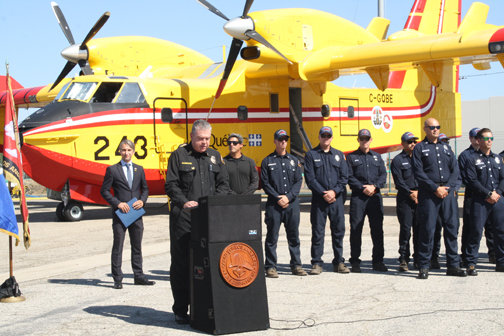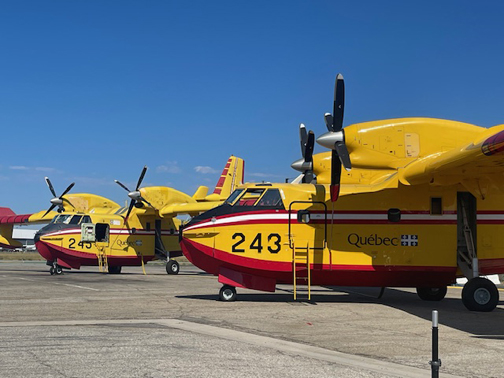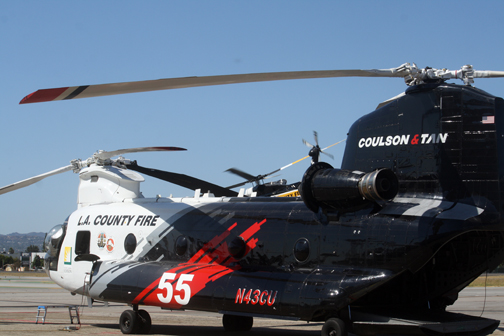
Photos by Mary O’KEEFE
By Mary O’KEEFE
“In 2023, Quick Reaction Force (QRF) dropped about 900,000 gallons of water/retardant on about 64 fires. This year, seven months in, we’ve already dropped over 1,300,000 gallons on 87 fires,” said a Los Angeles County Fire Dept. (LACoFD) spokesperson.
QRF is a 24/7 fire suppression helitanker fleet that operates in the counties of LA, Orange and Ventura. It began about six years ago as a piece of the Southern California fire fighting force.
The information was shared during an event this week at Van Nuys Airport where LA County Fire personnel provided an update on the 2024 wildfire season as well as sharing the seasonal arrival of the SuperScoopers from the government of Québec and the lease of a Coulson Group Chinook CH-47, known as Helitanker 55, made possible through a partnership with Southern California Edison.

For 31 years LACoFD has leased a pair of CL-415 SuperScoopers. The SuperScoopers were secured in 1994 after the devastating Topanga fire. This year they were placed in service on Sept. 1.
This year, 2024, is shaping up to be a big fire season. The area that draws the most concern is what hasn’t burned in the last three years.
“That’s pretty much all of the canyons and valleys of Los Angeles County,” said the spokesperson. “So everything is up for grabs right now.”
“We proudly welcome back the SuperScoopers to join our County of Los Angeles Fire Dept. fleet of firefighting aircraft,” said County of LA Fire Chief Anthony C. Marrone.
Marrone expressed his appreciation to David Ruiz, Public Affairs and Cooperation director, Quebec government – LA office, SCE and the Coulson Group for their support.

“I’m grateful to each of these partners, along with the County of Los Angeles Board of Supervisors, for their support in ensuring the County of Los Angeles Fire Dept. has the necessary air resources to quickly and effectively fight wildfires both day and night,” Marrone said.
He spoke about the significant rain Southern California received over the last two years, which was needed for the state; however, that rain “produced an abundant amount of vegetation throughout Southern California.”
“This year we saw areas that received nearly 200% of the normal rainfall. Unfortunately this vegetation is now dry and it’s becoming fuel for our wildfires like the Bridge Fire today that is currently burning in the Angeles National Forest, east of Camp Williams at East Fork and Glendora Mountain Ridge Road,” Marrone said.
He added the increased vegetation and dry conditions are why everyone must remain vigilant.
“[I want to] share with residents and communities the importance of being prepared for the wildfires that we have seen this summer and that will continue into the fall when the dangerous Santa Ana winds arrive,” he said.
With the addition of the SuperScoopers and other helicopters, LACoFD is “prepared to do what is necessary to aggressively fight wildfires,” Marrone said.
“The 2018 Woolsey Fire, 2020 Bobcat Fire and 2022 Route Fire are vivid reminders of how we can never let our guard down as this year’s wildfire season has the potential to be just as devastating,” he said.
With the arrival Québec 1 and Québec 2, and the Helitanker 55, LACoFD has increased its aerial capabilities to fight fires during both day and night.
Though Marrone urges preparation, he is cautious in saying Southern California’s fire season is year round.
“We all know that we’ve come off of two years of a lot of rain and we really haven’t had a fire season for the last two years,” he said. “For us here in LA County, it’s really July through December and sometimes, if the Santa Ana winds extend into January, February and March, we could still have these resource here.”
In addition to the Helitanker 55 LA County Fire has access to Helitanker 47 and Helitanker 50.
The Southern California mutual aid program is something that has been studied and shared throughout several fire departments.
Marrone said as part of that mutual aid program the four fire chiefs from LA, Orange and Ventura counties and LA City Fire speak weekly.
“Sometimes we talk more often than that,” Marrone said. “When one of us needs resources, we call the other three and we get them rolling on the road while those orders make their way through the mutual aid process that is coordinated out of Sacramento. We have put in a layer to make sure that we quickly and efficiently get the resources before the orders can actually be processed. So we get those resources on the road because minutes matter when it comes to structure defense.”
Marrone advised residents to go to the LACoFD website at fire.lacounty.gov/rsg to learn more about RSG – Ready, Set, Go, which helps residents prepare for wildfires.
